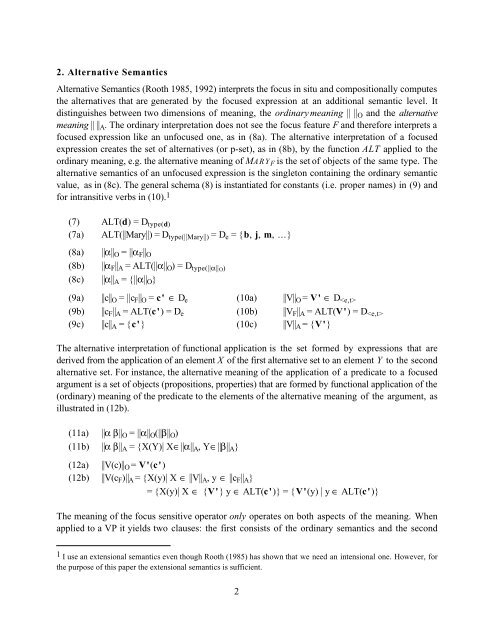Focus in complex noun phrases
Focus in complex noun phrases
Focus in complex noun phrases
Create successful ePaper yourself
Turn your PDF publications into a flip-book with our unique Google optimized e-Paper software.
2. Alternative Semantics<br />
Alternative Semantics (Rooth 1985, 1992) <strong>in</strong>terprets the focus <strong>in</strong> situ and compositionally computes<br />
the alternatives that are generated by the focused expression at an additional semantic level. It<br />
dist<strong>in</strong>guishes between two dimensions of mean<strong>in</strong>g, the ord<strong>in</strong>ary mean<strong>in</strong>g || || O and the alternative<br />
mean<strong>in</strong>g || || A . The ord<strong>in</strong>ary <strong>in</strong>terpretation does not see the focus feature F and therefore <strong>in</strong>terprets a<br />
focused expression like an unfocused one, as <strong>in</strong> (8a). The alternative <strong>in</strong>terpretation of a focused<br />
expression creates the set of alternatives (or p-set), as <strong>in</strong> (8b), by the function ALT applied to the<br />
ord<strong>in</strong>ary mean<strong>in</strong>g, e.g. the alternative mean<strong>in</strong>g of MARY F is the set of objects of the same type. The<br />
alternative semantics of an unfocused expression is the s<strong>in</strong>gleton conta<strong>in</strong><strong>in</strong>g the ord<strong>in</strong>ary semantic<br />
value, as <strong>in</strong> (8c). The general schema (8) is <strong>in</strong>stantiated for constants (i.e. proper names) <strong>in</strong> (9) and<br />
for <strong>in</strong>transitive verbs <strong>in</strong> (10). 1<br />
(7) ALT(d) = D type(d)<br />
(7a) ALT(||Mary||) = D type(||Mary||) = D e = {b, j, m, ...}<br />
(8a) ||α|| O = ||α F || O<br />
(8b) ||α F || A = ALT(||α|| O ) = D type(||α||O)<br />
(8c) ||α|| A = {||α|| O }<br />
(9a) ||c|| O = ||c F || O = c' ∈ D e (10a) ||V|| O = V' ∈ D <br />
(9b) ||c F || A = ALT(c') = D e (10b) ||V F || A = ALT(V') = D <br />
(9c) ||c|| A = {c'} (10c) ||V|| A = {V'}<br />
The alternative <strong>in</strong>terpretation of functional application is the set formed by expressions that are<br />
derived from the application of an element X of the first alternative set to an element Y to the second<br />
alternative set. For <strong>in</strong>stance, the alternative mean<strong>in</strong>g of the application of a predicate to a focused<br />
argument is a set of objects (propositions, properties) that are formed by functional application of the<br />
(ord<strong>in</strong>ary) mean<strong>in</strong>g of the predicate to the elements of the alternative mean<strong>in</strong>g of the argument, as<br />
illustrated <strong>in</strong> (12b).<br />
(11a) ||α β|| O = ||α|| O (||β|| O )<br />
(11b) ||α β|| A = {X(Y)| X∈||α|| A , Y∈||β|| A }<br />
(12a) ||V(c)|| O = V'(c')<br />
(12b) ||V(c F )|| A = {X(y)| X ∈ ||V|| A , y ∈ ||c F || A }<br />
= {X(y)| X ∈ {V'} y ∈ ALT(c')} = {V'(y) | y ∈ ALT(c')}<br />
The mean<strong>in</strong>g of the focus sensitive operator only operates on both aspects of the mean<strong>in</strong>g. When<br />
applied to a VP it yields two clauses: the first consists of the ord<strong>in</strong>ary semantics and the second<br />
1 I use an extensional semantics even though Rooth (1985) has shown that we need an <strong>in</strong>tensional one. However, for<br />
the purpose of this paper the extensional semantics is sufficient.<br />
2
















